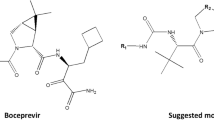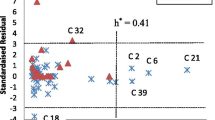Abstract
The hepatitis C virus (HCV), of the family flaviviridae, is one of the major causes of chronic liver diseases. Until the year 2012, HCV infections were treated using PEG-interferon and ribavirin combinations, which have a low cure rate and severe side effects. Currently, many direct-acting antivirals (DAAs) are available, e.g. protease inhibitors, NS5A and polymerase inhibitors. These drugs have proven to be efficient in interferon-free treatment combinations and capable of enhancing the cure rate to above 90 %. Unlike PEG-interferon and ribavirin combinations, DAAs select for resistance in HCV. The R155K mutation in the HCV was found to resist all the currently available protease inhibitors. Here, we studied biophysical parameters like pocket (cavity) geometries and stabilizing residues of HCV 1a NS3/4A protease in wild type and mutants. We also studied HCV 1a NS3/4A protease’s catalytic residues: their accessibility, energy, flexibility and binding to Phase II oral protease inhibitor vedroprevir (GS-9451), and compared these parameters between wild type and mutant(s). All these studies were performed using various bioinformatics tools (e.g. Swiss-PdbViewer and Schrödinger’s Maestro) and web servers (e.g. DoGSiteScorer, SRide, ASA-View, WHAT IF, elNémo, CABS-flex, PatchDock and PLIP). From our study, we found that introduction of R155K, A156T or D168A mutation to wild-type NS3/4A protease increases the pocket’s volume, surface (in the R155K mutant, surface decreases), lipo surface and depth and decreases the number of stabilizing residues. Additionally, differences in catalytic residues’ solvent accessibility, energy, root-mean-square deviation (RMSD) and flexibility between wild type and mutants might explain changes in the protease activity and the resistance to protease inhibitors.






Similar content being viewed by others
Abbreviations
- HCV:
-
Hepatitis C virus
- PDB:
-
Protein Data Bank
- NS3:
-
Non-structural protein 3
- NS4A:
-
Non-structural protein 4A
- DAA:
-
Direct-acting antivirals
- RMSD:
-
Root-mean-square deviation
References
Mohd Hanafiah K, Groeger J, Flaxman AD, Wiersma ST (2013) Global epidemiology of hepatitis C virus infection: new estimates of age-specific antibody to HCV seroprevalence. Hepatology 57(4):1333–1342
Bartenschlager R, Lohmann V, Penin F (2013) The molecular and structural basis of advanced antiviral therapy for hepatitis C virus infection. Nat Rev Microbiol 11(7):482–496
Nakano T, Lau GM, Lau GM, Sugiyama M, Mizokami M (2012) An updated analysis of hepatitis C virus genotypes and subtypes based on the complete coding region. Liver Int 32(2):339–345
Simmonds P, Bukh J, Combet C, Deléage G, Enomoto N, Feinstone S, Halfon P, Inchauspé G, Kuiken C, Maertens G, Mizokami M, Murphy DG, Okamoto H, Pawlotsky JM, Penin F, Sablon E, Shin-I T, Stuyver LJ, Thiel HJ, Viazov S, Weiner AJ, Widell A (2005) Consensus proposals for a unified system of nomenclature of hepatitis C virus genotypes. Hepatology 42(4):962–973
Messina JP, Humphreys I, Flaxman A, Brown A, Cooke GS, Pybus OG, Barnes E (2015) Global distribution and prevalence of hepatitis C virus genotypes. Hepatology 61(1):77–87
Akamatsu N, Sugawara Y (2012) Liver transplantation and hepatitis C. Int J Hepatol 2012:686135
Tan SL (ed) (2006) Hepatitis C viruses: genomes and molecular biology. Horizon Bioscience, Norfolk
Sardana VV, Blue JT, Zugay-Murphy J, Sardana MK, Kuo LC (1999) An uniquely purified HCV NS3 protease and NS4A(21-34) peptide form a highly active serine protease complex in peptide hydrolysis. Protein Expr Purif 16(3):440–447
Manns MP, McHutchison JG, Gordon SC, Rustgi VK, Shiffman M, Reindollar R, Goodman ZD, Koury K, Ling M, Albrecht JK (2001) Peginterferon alfa-2b plus ribavirin compared with interferon alfa-2b plus ribavirin for initial treatment of chronic hepatitis C: a randomised trial. Lancet 358(9286):958–965
Gritsenko D, Hughes G (2015) Ledipasvir/Sofosbuvir (Harvoni): improving options for hepatitis C virus infection. Pharmacy Ther 40(4):256–259, 276
Halfon P, Locarnini S (2011) Hepatitis C virus resistance to protease inhibitors. J Hepatol 55(1):192–206
Wu S, Kanda T, Nakamoto S, Imazeki F, Yokosuka O (2013) Hepatitis C virus protease inhibitor-resistance mutations: our experience and review. World J Gastroenterol 19(47):8940–8948
Palanisamy N, Danielsson A, Kokkula C, Yin H, Bondeson K, Wesslén L, Duberg AS, Lennerstrand J (2013) Implications of baseline polymorphisms for potential resistance to NS3 protease inhibitors in Hepatitis C virus genotypes 1a, 2b and 3a. Antivir Res 99(1):12–17
Andonov A, Kadkhoda K, Osiowy C, Kaita K (2013) Pretreatment resistance to hepatitis C virus protease inhibitors boceprevir/telaprevir in hepatitis C virus subgenotype 1a-infected patients from Manitoba. Can J Gastroenterol 27(7):414–416
Kuntzen T, Timm J, Berical A, Lennon N, Berlin AM, Young SK, Lee B, Heckerman D, Carlson J, Reyor LL, Kleyman M, McMahon CM, Birch C, Schulze Zur Wiesch J, Ledlie T, Koehrsen M, Kodira C, Roberts AD, Lauer GM, Rosen HR, Bihl F, Cerny A, Spengler U, Liu Z, Kim AY, Xing Y, Schneidewind A, Madey MA, Fleckenstein JF, Park VM, Galagan JE, Nusbaum C, Walker BD, Lake-Bakaar GV, Daar ES, Jacobson IM, Gomperts ED, Edlin BR, Donfield SM, Chung RT, Talal AH, Marion T, Birren BW, Henn MR, Allen TM (2008) Naturally occurring dominant resistance mutations to hepatitis C virus protease and polymerase inhibitors in treatment-naïve patients. Hepatology 48(6):1769–1778
Lindström I, Kjellin M, Palanisamy N, Bondeson K, Wesslén L, Lannergard A, Lennerstrand J (2015) Prevalence of polymorphisms with significant resistance to NS5A inhibitors in treatment-naive patients with hepatitis C virus genotypes 1a and 3a in Sweden. Infect Dis (Lond) 47(8):555–562
Lontok E, Harrington P, Howe A, Kieffer T, Lennerstrand J, Lenz O, McPhee F, Mo H, Parkin N, Pilot-Matias T, Miller V (2015) Hepatitis C virus drug resistance-associated substitutions: state of the art summary. Hepatology 62(5):1623–1632
He Y, King MS, Kempf DJ, Lu L, Lim HB, Krishnan P, Kati W, Middleton T, Molla A (2008) Relative replication capacity and selective advantage profiles of protease inhibitor-resistant hepatitis C virus (HCV) NS3 protease mutants in the HCV genotype 1b replicon system. Antimicrob Agents Chemother 52(3):1101–1110
Purohit R, Rajasekaran R, Sudandiradoss C, George Priya Doss C, Ramanathan K, Rao S (2008) Studies on flexibility and binding affinity of Asp25 of HIV-1 protease mutants. Int J Biol Macromol 42(4):386–391
Romano KP, Ali A, Aydin C, Soumana D, Ozen A, Deveau LM, Silver C, Cao H, Newton A, Petropoulos CJ, Huang W, Schiffer CA (2012) The molecular basis of drug resistance against hepatitis C virus NS3/4A protease inhibitors. PLoS Pathog 8(7):e1002832. doi:10.1371/journal.ppat.1002832
Volkamer A, Kuhn D, Rippmann F, Rarey M (2012) DoGSiteScorer: a web server for automatic binding site prediction, analysis and druggability assessment. Bioinformatics 28(15):2074–2075
Magyar C, Gromiha MM, Pujadas G, Tusnády GE, Simon I (2005) SRide: a server for identifying stabilizing residues in proteins. Nucleic Acids Res 33(Web Server issue):W303–W305
Ahmad S, Gromiha M, Fawareh H, Sarai A (2004) ASAView: database and tool for solvent accessibility representation in proteins. BMC Bioinform 5:51
Suhre K, Sanejouand YH (2004) ElNemo: a normal mode web server for protein movement analysis and the generation of templates for molecular replacement. Nucleic Acids Res 32(Web Server issue):W610–W614
Jamroz M, Kolinski A, Kmiecik S (2013) CABS-flex: server for fast simulation of protein structure fluctuations. Nucleic Acids Res 41(Web Server issue):W427–W431
Schüttelkopf AW, van Aalten DM (2004) PRODRG: a tool for high-throughput crystallography of protein-ligand complexes. Acta Crystallogr D Biol Crystallogr 60(Pt 8):1355–1363
Schneidman-Duhovny D, Inbar Y, Nussinov R, Wolfson HJ (2005) PatchDock and SymmDock: servers for rigid and symmetric docking. Nucleic Acids Res 33(Web Server issue):W363–W367
Mauss S, Berg T, Rockstroh J, Sarrazin C, Wedemeyer H (eds) (2013) Hepatology 2013 a clinical textbook, 4th edn. Flying Publisher, Düsseldorf. ISBN 978-3-924774-90-5
Salentin S, Schreiber S, Haupt VJ, Adasme MF, Schroeder M (2015) PLIP: fully automated protein-ligand interaction profiler. Nucleic Acids Res 43(W1):W443–W447
Gelly JC, Joseph AP, Srinivasan N, de Brevern AG (2011) iPBA: a tool for protein structure comparison using sequence alignment strategies. Nucleic Acids Res 39(Web Server issue):W18–W23
Bowie JU, Lüthy R, Eisenberg D (1991) A method to identify protein sequences that fold into a known three-dimensional structure. Science 253(5016):164–170
Lüthy R, Bowie JU, Eisenberg D (1992) Assessment of protein models with three-dimensional profiles. Nature 356(6364):83–85
Romano KP, Ali A, Royer WE, Schiffer CA (2010) Drug resistance against HCV NS3/4A inhibitors is defined by the balance of substrate recognition versus inhibitor binding. Proc Natl Acad Sci USA 107(49):20986–20991
Tong X, Bogen S, Chase R, Girijavallabhan V, Guo Z, Njoroge FG, Prongay A, Saksena A, Skelton A, Xia E, Ralston R (2008) Characterization of resistance mutations against HCV ketoamide protease inhibitors. Antivir Res 77(3):177–185
Tong X, Chase R, Skelton A, Chen T, Wright-Minogue J, Malcolm BA (2006) Identification and analysis of fitness of resistance mutations against the HCV protease inhibitor SCH 503034. Antivir Res 70(2):28–38
Lin C, Gates CA, Rao BG, Brennan DL, Fulghum JR, Luong YP, Frantz JD, Lin K, Ma S, Wei YY, Perni RB, Kwong AD (2005) In vitro studies of cross-resistance mutations against two hepatitis C virus serine protease inhibitors, VX-950 and BILN 2061. J Biol Chem 280(44):36784–36791
Tama F, Sanejouand YH (2001) Conformational change of proteins arising from normal mode calculations. Protein Eng 14(1):1–6
Meeprasert A, Hannongbua S, Rungrotmongkol T (2014) Key binding and susceptibility of NS3/4A serine protease inhibitors against hepatitis C virus. J Chem Inf Model 54(4):1208–1217
McPhee F, Friborg J, Levine S, Chen C, Falk P, Yu F, Hernandez D, Lee MS, Chaniewski S, Sheaffer AK, Pasquinelli C (2012) Resistance analysis of the hepatitis C virus NS3 protease inhibitor asunaprevir. Antimicrob Agents Chemother 56(7):3670–3681
Dvory-Sobol H, Wong KA, Ku KS, Bae A, Lawitz EJ, Pang PS, Harris J, Miller MD, Mo H (2012) Characterization of resistance to the protease inhibitor GS-9451 in Hepatitis C virus-infected patients. Antimicrob Agents Chemother 56(10):5289–5295
Robert X, Gouet P (2014) Deciphering key features in protein structures with the new ENDscript server. Nucleic Acids Res 42(W1):W320–W324
Acknowledgments
N.P. would like to thank EDP Department of Sakthi Sugars Ltd., Sakthi Nagar, India, for providing the computing facility for this study. N.P. would also like to thank Dr. Rituraj Purohit (CSIR-IHBT, India) for his kind help and for his critical suggestions about the manuscript. The authors would like to thank Sarah Lam for her grammatical assistance.
Author information
Authors and Affiliations
Corresponding author
Ethics declarations
Conflict of interest
None.
Rights and permissions
About this article
Cite this article
Palanisamy, N., Lennerstrand, J. Biophysical Studies on HCV 1a NS3/4A Protease and Its Catalytic Triad in Wild Type and Mutants by the In Silico Approach. Interdiscip Sci Comput Life Sci 10, 143–156 (2018). https://doi.org/10.1007/s12539-016-0177-4
Received:
Revised:
Accepted:
Published:
Issue Date:
DOI: https://doi.org/10.1007/s12539-016-0177-4




